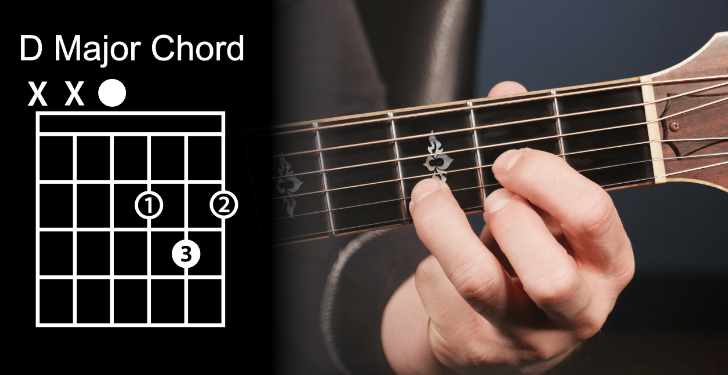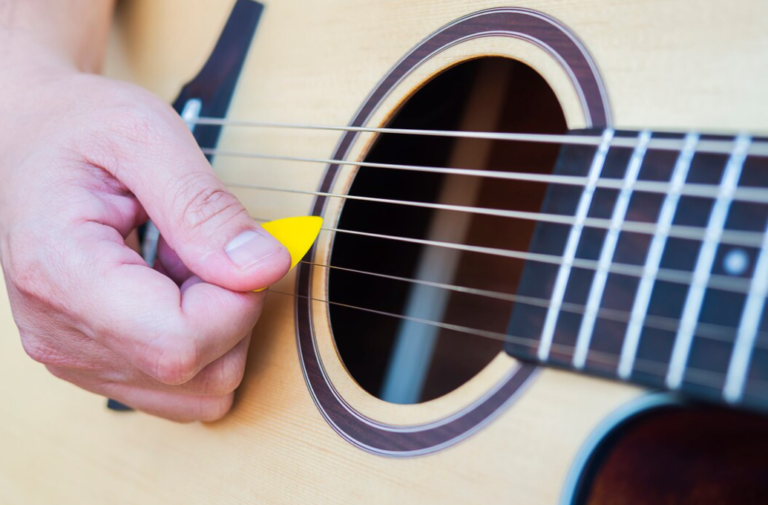D Major Chord on Guitar: The Guide You Need (Guaranteed)
The D major chord, with its uplifting and vibrant sound, is an essential chord for guitar players of all levels. Its presence in numerous songs across different genres makes it a must-learn for beginners. In this guide, we’ll take you through a step-by-step process to play the D major chord with finesse. (PS: D Chord Guitar)
Step 1: How Do I Play The D Major Chord?
- Finger Placement: Place your index finger on the second fret of the G string (third string), your middle finger on the second fret of the high E string (first string), and your ring finger on the third fret of the B string (second string).
- Thumb Position: Rest your thumb in the middle of the neck’s back, giving you a better grip and easier chord formation.
Step 2: Mastering the Strumming Technique
- Strumming Strings: Start your strum from the fourth string (D string) and move downwards. Avoid striking the fifth and sixth strings as they are not part of the D major chord.
- Strumming Technique: Maintain a relaxed wrist motion for a smooth and melodic strumming sound.
Step 3: Ensuring Clear and Crisp Tones
- Pressing the Strings: Apply firm pressure on the strings with your fingers. Loose contact can result in an unpleasant buzzing sound.
- Finger Arching: Arch your fingers adequately to prevent accidentally muting adjacent strings.
Step 4: Practice Guidelines for Progress
- Repetition: Consistent practice is the key to success. Start slowly and focus on achieving clarity in your chord formation.
- Transitioning: Work on smoothly transitioning to and from the D major chord with other common chords like G major and A major.
- Listening: Pay close attention to the sound you produce. It should be clear and resonant.
Theory
Picture this: A vibrant D major chord echoing from your guitar, filling the room with its bright and uplifting sound. It’s like a ray of pop music, isn’t it? This chord, my friend, is more than just a combination of notes. It’s a triad that sings with three distinct voices – D, F#, and A.
Those notes? They’re born from the D major scale, which is like a musical family of seven notes. Our D major chord picks the 1st, 3rd, and 5th members of this family – D, F#, and A.
Now let’s dive deeper into this chord, fancy pants. The Root (D) is the heartbeat, the name-giver. The Major Third (F#), four semitones above the root, is the joyful spirit, lending a bright and happy sound. And the Perfect Fifth (A), seven semitones above the root, is the backbone, adding stability and fullness.
So, back up. Imagine your fingers on the guitar strings, playing this chord. You start from the open D string, letting the notes D, F#, and A ring out. But remember, these notes can dance in different orders and octaves, changing the chord’s voicing without losing its identity. It’s still our radiant D major as long as D, F#, and A are present.
Ever wonder about the role of D major in the symphony of music? In Western tunes, it often serves as the comforting home base, the tonic in the key of D major. But change the key, and its role transforms. In G major, for instance, it becomes the dominant chord, stirring up tension that yearns to resolve back to G major. (get ready to put on that 17th-century grey wig)
Remember those moments when a song made you feel triumphant, joyful, or simply happy? Chances are, the D major chord was there, spreading its uplifting charm across genres. Think in Christianity or the catholic religion “Oh come all ye faithful” or anything else really.
But wait, there’s more! Our D major has many faces. Beyond the basic triad, it can dress up as D major 7, D add9, or D6, each adding different notes to bring a unique flavor and complexity.
So, you see, understanding the D major chord is like getting to know a fascinating character in your musical story. It’s not just about how to play it, but also why it sounds the way it does and how it fits into the grand funk railroad of music.






